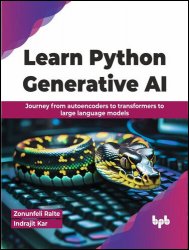 Название: Learn Python Generative AI: Journey from autoencoders to transformers to large language models
Название: Learn Python Generative AI: Journey from autoencoders to transformers to large language modelsАвтор: Zonunfeli Ralte, Indrajit Kar
Издательство: BPB Publications
Год: 2024
Страниц: 471
Язык: английский
Формат: pdf, epub
Размер: 16.5 MB
Learn to unleash the power of AI creativity.
Key Features:
- Understand the core concepts related to generative AI.
- Different types of generative models and their applications.
- Learn how to design generative AI neural networks using Python and TensorFlow.
Description:
This book researches the intricate world of generative Artificial Intelligence, offering readers an extensive understanding of various components and applications in this field.
The book begins with an in-depth analysis of generative models, providing a solid foundation and exploring their combination nuances. It then focuses on enhancing TransVAE, a variational autoencoder, and introduces the Swin Transformer in generative AI. The inclusion of cutting edge applications like building an image search using Pinecone and a vector database further enriches its content. The narrative shifts to practical applications, showcasing GenAI's impact in healthcare, retail, and finance, with real-world examples and innovative solutions. In the healthcare sector, it emphasizes AI's transformative role in diagnostics and patient care. In retail and finance, it illustrates how AI revolutionizes customer engagement and decision making. The book concludes by synthesizing key learnings, offering insights into the future of generative AI, and making it a comprehensive guide for diverse industries.
Readers will find themselves equipped with a profound understanding of generative AI, its current applications, and its boundless potential for future innovations.
Chapter 1: Introducing Generative AI - The objective of this chapter is to provide a comprehensive understanding of generative models, including an overview of generative models, a comparison of discriminative vs generative models, an introduction to the types of discriminative and generative models, as well as their strengths and weaknesses. By the end of the content, readers should be able to differentiate between discriminative and generative models, understand the different types of each, and make informed decisions about which type of model is most appropriate for their needs.
Chapter 2: Designing Generative Adversarial Networks - In this chapter, the objective is to delve into the multifaceted landscape of GANs by comprehensively exploring various types of GANs and their intricate architectures. By the end of this chapter, readers will be equipped with a solid understanding of the architecture, equations, and crucial design factors associated with different GAN variants. The chapter will dissect discriminator and generator losses, shed light on pivotal GAN types, including Vanilla GAN, Deep Convolutional GAN, Wasserstein GAN, Conditional GAN, CycleGAN, Progressive GAN, StyleGAN, and Pix2Pix, and address the major challenges encountered in designing effective GAN architectures.
Chapter 3: Training and Developing Generative Adversarial Networks - The objective of this book chapter is to provide readers with a comprehensive understanding of the process of training and tuning GANs, including the latest techniques and best practices for improving the stability and performance of GAN models.
...
Chapter 13: Key Learnings - The objective of this chapter is to synthesize and distill the core teachings and insights from chapters one through twelve. It aims to provide readers with a comprehensive summary, highlighting the key concepts, important takeaways, and significant learnings obtained from each preceding chapter. By consolidating this knowledge, the chapter seeks to offer a holistic understanding of the subject matter, reinforcing key ideas, and preparing readers for further exploration or application of the discussed principles. Ultimately, the objective is to enhance comprehension, retention, and practical application of the cumulative wisdom acquired throughout the previous chapters.
What you will learn:
- Acquire practical skills in designing and implementing various generative AI models.
- Gain expertise in vector databases and image embeddings, crucial for image search and data retrieval.
- Navigate challenges in healthcare, retail, and finance using sector specific insights.
- Generate images and text with VAEs, GANs, LLMs, and vector databases.
- Focus on both traditional and cutting edge techniques in generative AI.
Who this book is for:
This book is for current and aspiring emerging AI deep learning professionals, architects, students, and anyone who is starting and learning a rewarding career in generative AI.
Скачать Learn Python Generative AI: Journey from autoencoders to transformers to large language models